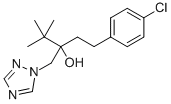Hexaconazole , Analysis standard product, 98% , 79983-71-4
Synonym(s):
(±)-2-(2,4-Dichlorophenyl)-1-(1H-1,2,4-triazol-1-yl)-2-hexanol
CAS NO.:79983-71-4
Empirical Formula: C14H17Cl2N3O
Molecular Weight: 314.21
MDL number: MFCD00144441
EINECS: 413-050-7
| Pack Size | Price | Stock | Quantity |
| 100MG | RMB239.20 | In Stock |
|
| others | Enquire |
PRODUCT Properties
| Melting point: | 111°C |
| Boiling point: | 490.3±55.0 °C(Predicted) |
| Density | d25 1.29 |
| vapor pressure | 1.8 x l0-6 Pa (20 °C) |
| refractive index | 1.5490 (estimate) |
| storage temp. | Inert atmosphere,Room Temperature |
| solubility | DMSO: Soluble; Methanol: Soluble |
| Water Solubility | 17 mg l-1(20 °C) |
| form | Solid |
| pka | 12.26±0.29(Predicted) |
| color | White to off-white |
| Merck | 13,4700 |
| BRN | 8328399 |
| InChIKey | STMIIPIFODONDC-UHFFFAOYSA-N |
| NIST Chemistry Reference | 1H-1,2,4-triazole-1-ethanol, «alpha»-butyl-«alpha»-(2,4-dichlorophenyl)-, (.+/-.)-(79983-71-4) |
| EPA Substance Registry System | Hexaconazole (79983-71-4) |
Description and Uses
Hexaconazole is a broad-spectrum triazole fungicide that inhibits ergosterol biosynthesis via inhibition of the cytochrome P450-dependent 14α-demethylation of lanosterol, which results in disruption of the fungal cell membrane and cell death. It is fungicidal against the powdery mildews B. graminis and S. cucurbitae on cucumber plants in a concentration-dependent manner and is curative against powdery mildew on barley plants when used at a concentration of 6.7 mg/L. It also inhibits growth of R. bataticola and S. rolfsii (ED50s = 6.35 and 1.27 mg/L, respectively). Exogenous application of hexaconazole (15 mg/L) to M. chamomilla plants improves water, proline, and protein contents as well as increases non-enzymatic and enzymatic antioxidant and apigenin-7-glucoside content during a water deficit stress tolerance test. Hexaconazole inhibits the differentiation of mouse embryonic stem cells into cardiomyocytes (EC50 = 16.6 μM). It also induces bone morphological defects in mouse fetuses when administered to pregnant adult females during gestation.
Hexaconazole is a systematic fungicide of the triazole class. Hexaconazole has a broad spectrum antifungal activity and is commonly used in the control of apple, coffee and peanut diseases.
Safety
| Symbol(GHS) |   GHS07,GHS09 |
| Signal word | Warning |
| Hazard statements | H302-H317-H411 |
| Precautionary statements | P261-P264-P273-P280-P301+P312-P302+P352 |
| Hazard Codes | Xn;N,N,Xn |
| Risk Statements | 22-43-51/53 |
| Safety Statements | 2-24-37-61 |
| RIDADR | UN3077 9/PG 3 |
| WGK Germany | 2 |
| RTECS | XZ4803200 |
| Toxicity | LD50 orally in mallard ducks, male rats, female rats: >4000, 2189, 6071 mg/kg; dermally in rats: >2000 mg/kg; LC50 (96 hour) in rainbow trout: >6.7 mg/l (Shephard) |



